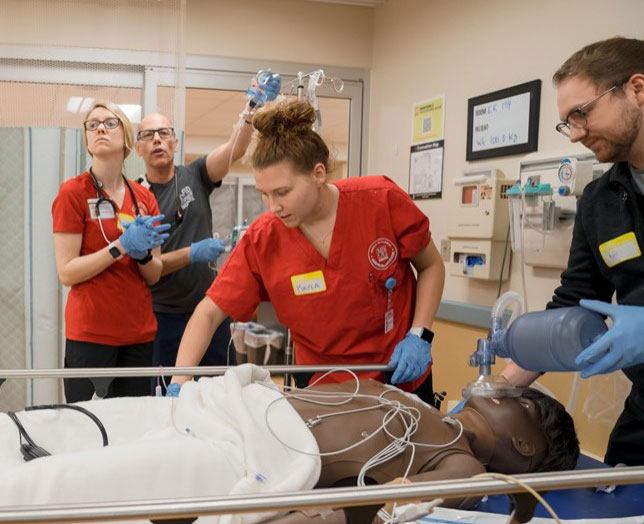Disaster workshop prepares nursing students to take action
In the world of health care, no two days are the same. Industrial accidents, natural disasters, and mass casualty incidents are all very real emergencies that require the expertise of health care providers. These high-stress situations require health care professionals to act fast and work as a team while addressing an endless string of unexpected elements. To prepare students for life after graduation, the School of Nursing collaborated with the Medical College of Wisconsin (MCW) to host a disaster workshop for junior nursing students and MCW residents.
The disaster workshop included five stations. Three included hands-on learning experiences that featured high-fidelity mannikins as well as live actors portraying patients. Interprofessional teams of MSOE nursing students and MCW residents cared for a patient experiencing a chemical exposure in the emergency room, worked to triage patients in a mass casualty event following a tornado, and assisted a victim who was trapped under a beam after a simulated explosion. They also heard presentations from Flight for Life nurses on how to prepare a patient for transport as well as engaged in an active shooter presentation from MSOE Public Safety Sergeant Trevor Schmitt.

Station one was a chemical exposure simulation. For this, one MCW resident took the lead, calling out orders on what was needed to stabilize the patient. This included directions on the type and amounts of medications and fluids that were needed, intubation, and requesting information on patient status. Nursing students moved forward with monitoring vital signs, providing respiratory support, and administering IV fluids and medications to the patient.
“Working with the interdisciplinary team was even better than I could’ve imagined,” said Kayla McQuestion, MSOE nursing student. “The MCW resident in our group did a really good job at explaining everything as we went, which was really helpful.”
Throughout the simulation, the MCW residents asked MSOE students for assistance and checked in to see if they had questions or any other ideas while caring for the patients. This collaboration gave students an inside look at what their future careers will look like.
“Our nursing students will be working with physicians when they graduate, so this experience allows them to learn how to collaborate and communicate effectively when caring for a patient,” said Dr. Carol Sabel, School of Nursing professor and chair. “Collaboration and communication are essential for physicians and nurses in order to provide high quality patient care. This practice should help them to recognize the importance of this.”
A second station was a mass casualty, where students had to use incident command skills and SALT (sort, assess, lifesaving interventions, treatment/transportation) triage to prioritize patient care. This experience simulated the aftermath of a tornado with a multitude of patients needing assistance. Live actors portrayed a wide variety of injuries, ranging from hearing loss, difficulty breathing, amputations and even death. The students were required to triage the patients with different color cards to signify their care priority. The cards included green for minor injuries, yellow for “delayed care”, red as needs immediate attention, and black signifying the person was deceased.
The actors in this simulation included MSOE alumni, faculty, staff, nursing students and community members. They made sure the simulation was as realistic as possible by creating chaos with shouting, loud noises and movement. This chaos subjected students to a multitude of scenarios to prepare them for their futures.
“In today’s world, this is such a vital training for students,” said Sabel. “It exposes them to a lot of different situations. In just this room we have amputation, shortness of breath, a dead child—it helps them understand what can be emotional triggers for them, and how to work through that. If they are faced with something similar in real life, they can feel confident in their ability to react and help.”
Nursing student Tony Truong valued the opportunity to work as a team. “The teamwork was very cohesive,” said Truong. “We weren’t afraid to ask questions or help each other out. It was good to practice teamwork and the flow of how things would go when working in a hospital or health care setting.”
The final hands-on experience required the team to care for a patient that was stuck under a two-thousand-pound beam after an explosion in a brewery. Here the group needed to safely care for the patient both before and after the beam was removed. In this simulation, the lights were off, and the students wore headlamps while caring for the patient. Similar to the chemical exposure, the MCW resident took the lead in providing and directing the overall care that was needed to stabilize the patient and the nursing students provided care while using critical thinking to ask questions and make recommendations based on their observations.
Behind the scenes, an MCW facilitator manipulated the patient’s vital signs and overall status to challenge the students to think on their toes in an extreme situation. MCW and MSOE facilitators were also in the room with the participants to offer suggestions and guide the learning experience.
With just a few weeks left in the semester, this simulation was designed to give students an opportunity to practice incident command principles, work with an interprofessional team, understand the main principles of a mass casualty event, and gain practice reacting to a variety of situations. “The goal of this simulation was strictly to give students exposure to different scenarios so if faced with a mass casualty they can confidently say, ‘okay, I have training in this. I know what to do,’” explained Sabel.
